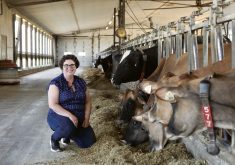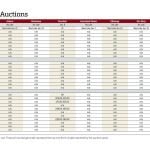The disruptions to business and industry caused or worsened by COVID-19 have been well documented in the media. How, exactly, are equipment makers being affected, and how are they fighting back? Are they all experiencing similar problems, and how significant are they?
To find out, Country Guide spoke with senior executives at three Canadian manufacturers. Here’s what they told us:
Adam Reid
Read Also

Building a farm legacy that outlasts you
A farm’s legacy isn’t just about the land; it’s also about the values and the impact that continue long after the current owner has stepped away.
VP sales and marketing, Versatile
“It’s a nightmare,” says Adam Reid, vice-president of sales and marketing at Winnipeg-based Versatile.
“It started in the spring of 2021, when we had a couple of suppliers warn us they were running into some challenges on their end, that they might be late in delivery. But it was only a couple, and we had some mitigation strategies.”
Mostly, the company rescheduled its production line to focus on products with a stable supply chain.
“Then in September we started seeing delivery delays from our cab supplier. They were having a hard time getting components on their end. Some plastic products were getting hard to come by from their suppliers. And then the wiring harness company was becoming a challenge.
“Then, it seemed like in October the dominos started to fall. I don’t think we’re alone in this. Talking to my colleagues in the industry, there was a tipping point somewhere in late summer, early fall. We all started to experience it. It became a waterfall after that.”
Meanwhile, the Winnipeg plant had a full build schedule ahead of it and delivery date obligations to meet.
“Demand is quite high,” Reid says. “We had an order program for our dealers back in the spring and essentially sold every tractor we were able to build for ’22 … every build slot was spoken for by a dealer by the end of September.”
Now, the challenge is getting the right component parts at the right time so the assembly line doesn’t grind to a halt.
“Before COVID we were planning our production anywhere from eight weeks to three months out,” Reid says. “We’d lock it in and that would be what we’d build. Now, almost weekly, we’re deciding what do we have enough components (of) to build this week.
The biggest challenge is cabs because there’s no way they can assemble a tractor without the cab on it already. When they do receive cabs, they get them on as many units as they can, so they’ve always got an inventory of cabbed units ready to put back into the line. That slows process though and adds costs.
There is also the problem of getting the components shipped to the plant. Ocean shipping delays are significant, requiring the company to look at alternatives. Versatile has had to turn to air freight to get certain shipments on time.
“That, of course, adds to the costs,” Reid says. “But it’s still better than shutting the factory down. We haven’t had to shut the production line down yet. But this isn’t a very efficient way to build a product.”
Despite all the efforts to keep production running smoothly, disruptions remain.
“I would say probably the biggest struggle is delivery dates. Most of these (tractors) are spoken for by dealers and a lot of them have been pre-sold to customers. We don’t have clear delivery timelines from our suppliers, so it’s very difficult for us to provide a clear delivery schedule to the dealers. It’s very frustrating for everyone.
“We’ve tried to keep the lines of communications open with our dealers as much as we can. But obviously the farmers are frustrated because they don’t know when the tractor is coming. The dealers are frustrated because we can’t tell them when the tractor is coming.
“We’re doing everything we can at the factory to pull enough components together to get a tractor together and get it on a truck. But it’s been a big struggle.”
Richelle Andreas
CEO, S3 Group Ltd.
“We’re more concerned about acquiring raw materials and having the labour to produce the components,” says Richelle Andreas, CEO of S3 Group Ltd. which sells much of its product to OEMs (original equipment manufacturers).
At its Swift Current, Sask. base, S3 Group produces sub-assemblies and parts that OEM manufacturers need to go in their equipment. And with so many brands trying to source parts from alternate suppliers due to supply chain problems, S3 Group has seen demand for its services increase.
“The current situation is creating a really interesting environment where we have unparalleled demand for what we do,” says Andreas. “There are a lot of people trying to re-shore and source from North America. We’re getting a lot of calls we wouldn’t otherwise get.”
All that sounds great, but the supply chain disruptions affecting OEMs have hit component suppliers just as hard.
S3 Group has been dealing with a bigger than normal labour shortage. Attracting workers to a smaller city in rural Saskatchewan has always had its challenges, but COVID-19 has magnified them.
“We’ve been very, very fortunate throughout COVID,” says Andreas. “But we find it’s causing some hesitancy when it comes to mobility of the workforce and people starting new jobs. Relocating in the COVID environment is a little bit overwhelming for some people. We rely heavily on immigration and that’s slowed down quite a bit during the last couple of years.
“The challenges we’re experiencing are making sure we have the raw materials coming in and making sure we have enough labour to satisfy the demand, specifically in the COVID environment.”
On the floor, electronics and resin (polymers and plastics) along with products sourced from offshore and that rely on ocean shipping through the port of Vancouver have proved hardest to source.
“In our business, as an entirety, we estimate about 30 per cent of our product is coming from offshore,” Andreas says.
Just as equipment brands that have had problems getting shipments from offshore suppliers have turned to companies like S3 Group, it too has attempted to source parts from North American producers. But that isn’t always possible
“Where we can, we’ve done so,” Andreas says. “But there are some limitations to that. For example, one of our businesses is to build spring tines, primarily for the agricultural industry. The best wire in the world for that application is coming out of Korea, and in the last five years there’s been a reduction in North American supply of that particular type of wire.”
Will the current situation cause a resurgence of raw material and component production in North America, reducing the shipping bottlenecks from future global shocks similar to COVID-19?
“Re-shoring is definitely part of the industry narrative right now,” she adds, “and I think it needs to be. But there’s going to be some challenges, or headwinds, that make that difficult, one of which is capitalization, and the other is going to be finding the manpower to do so. And I’m not just thinking of my local market; I’m thinking the U.S. as well as Canada.”
So a big part of any effort to rebuild core manufacturing capacity in North America comes back to labour shortages.
“In the last five years there’s been a lot of people think that manufacturing is not the career for them or not the career for their children,” Andreas says. “We’ve got some work to do to re-educate the population that manufacturing is a viable, sustainable healthy career.”
As companies create strategies to cope with long-term labour needs, the most pressing concern must be how much longer will today’s supply chain disruptions continue to drag on manufacturing.
“My crystal ball is pretty foggy,” says Andreas. “But I’d say we’re in for another two years of this. The employment situation is going to be longer.
“One of the things we watch closely is infrastructure. What happened in B.C. with the recent flooding, there’s a lot of narratives floating around about that, but one of the key things that came home for us is how reliant we are on infrastructure, and there’s a tremendous opportunity for governments to build ports, roads and rail capacity in our country. That could help us out tremendously. A lot of the supply chain issues we experience didn’t start with COVID.”
Don Henry
CEO, SeedMaster
“It’s been awful,” says Don Henry, CEO of Regina-based SeedMaster. “It should be really a good, buoyant time in the agriculture industry.”
Arranging for materiel procurement well ahead of time has kept factory workers busy with only minimal disruptions at the Regina plant.
“We really haven’t had too many delays in production,” Henry says. “We’ve been able to jump through the hoops and find supplies when we needed them. But the price increases have been devastating.”
Like most ag equipment brands, SeedMaster takes early orders for equipment. That means pricing sales contracts well ahead of actual manufacture, leaving brands holding the bag for unexpected increased costs, which is one area where COVID-19 has hit SeedMaster — and almost all others — fairly hard.
“We all take orders at a certain time, generally when seeding is over,” Henry says. “In our case that’s when we go out with our most aggressive programs to try to get orders in May and June so we can produce through the rest of the year until April and have everything out for seeding. Once we take that order in May, June or July, we honour that price. And we’ve had some crazy (cost) increases since that time, anywhere from 10 upwards to 50 per cent increases in some of our components, which has really devastated our gross margin. We’re honouring the contracts and wouldn’t change that, but it’s been devastating for profitability. It’s been a challenge for us, and I suspect most of us in the industry.”
Just as with other manufacturers, remaining flexible with its assembly schedule has also been an important tactic for Henry’s company to keep assembly line workers busy.
“We’ve had to stickhandle some production times,” Henry says.
“Specifically, we were expecting a shipment on October 13. We discovered on October 7 the shipment had been delayed six weeks. We had inventory on hand we were able to source from another supplier, otherwise we’d have been stopped. We’d have had people standing in assembly with nothing to do. We weren’t stopped, but that source was 30 per cent more expensive. We needed to keep producing to meet our deadline.”
In the current environment, orders that SeedMaster placed with suppliers no longer guarantee a price.
“A purchase order, the only thing it does is give us maybe a production slot, because generally the supplies will be late and it’ll be whatever the price is when we receive it,” Henry says.
Those cost increases will eventually have to be passed on to farmers. But with unpredictable input costs, how much to increase prices is difficult to pin down.
“We made a significant price increase in September,” Henry says. “We have a program on now for anyone that wants to order for summer production and we increased it significantly. I don’t know if it’ll be enough. Hopefully, it is.
“One of the positive things is the steel price index has started to come back down now,” Henry adds. “That’s the first time in a year that it wasn’t going up.”
Shipping problems are also plaguing manufacturers like SeedMaster, though.
“We shipped some product to Australia,” Henry says, relating a recent example. “The rate we were quoted was US$8,500. Our supplier changed their supplier for the shipping line, and when we got the invoice it came back at over US$19,000.”















